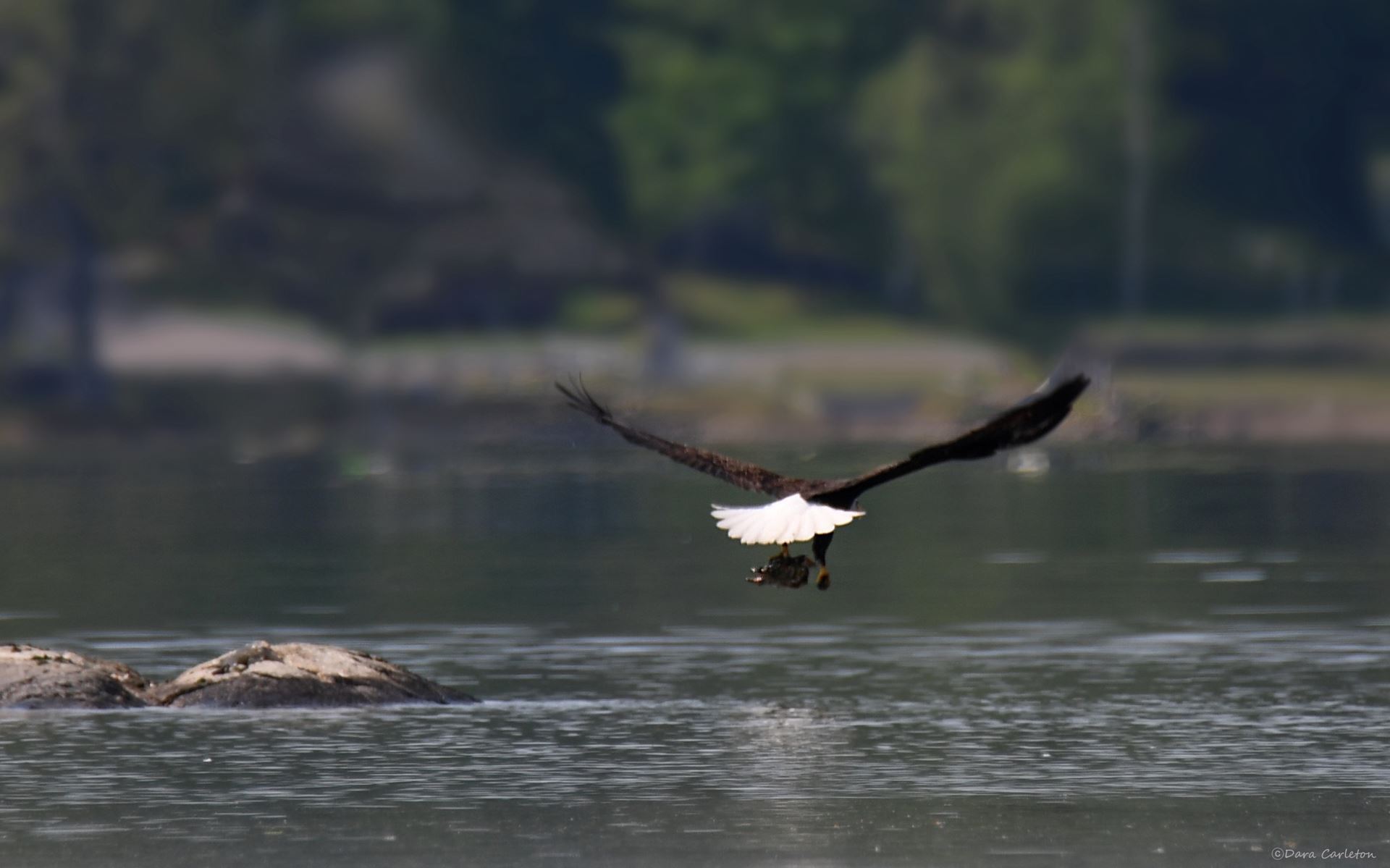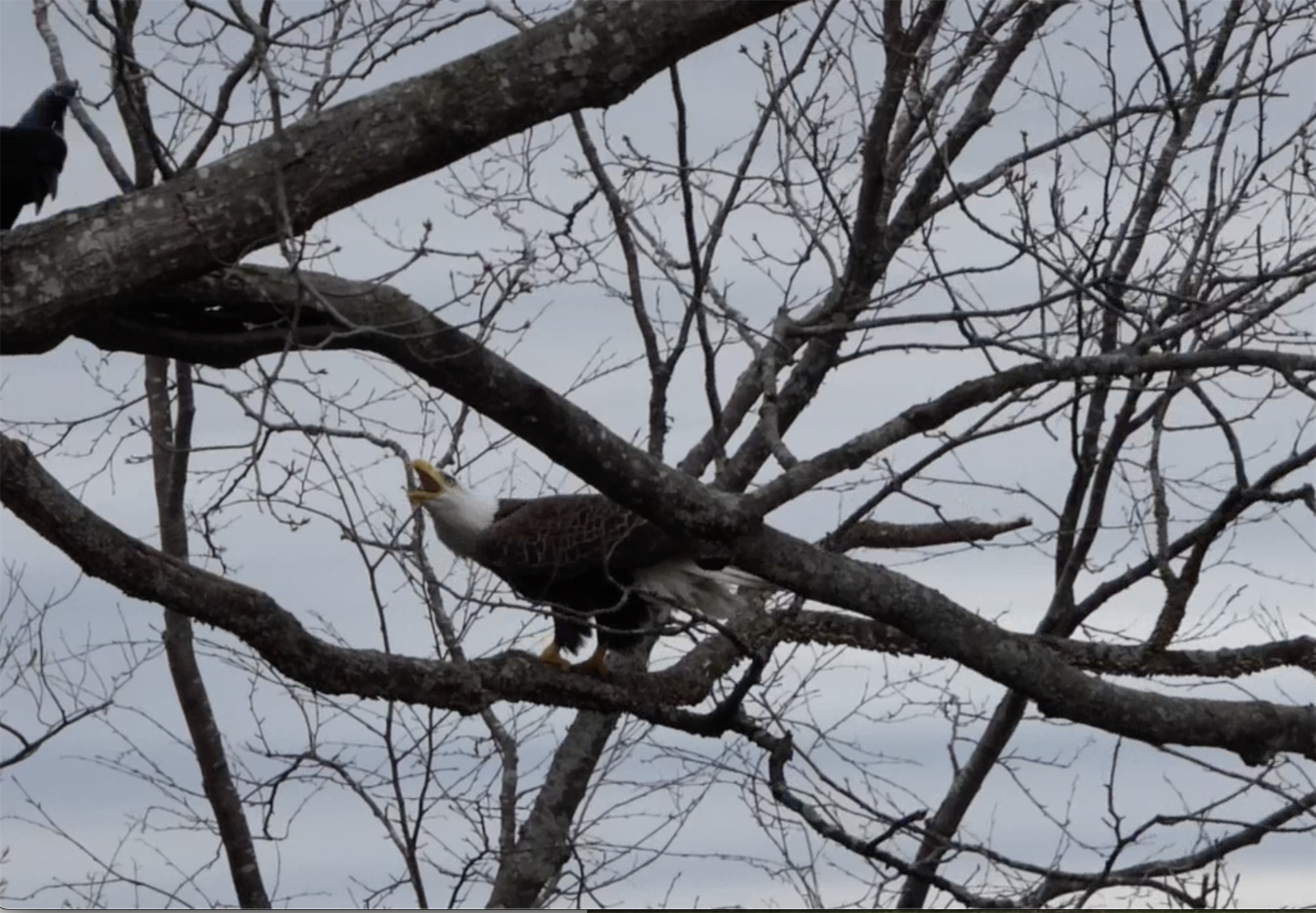Bald Eagles
Bald eagles, our national emblem since 1782, were a rare sight in New Hampshire in 1980, but their comeback has been strong. At Spofford Lake, local observers note that the first signs of a nest being built at ‘Wheeler Point’ occurred around 2015. It wasn’t until 2020 however, when two babies (eaglets) were spotted, a first in a very long time. While the nest suffered considerable wind damage that year, the eaglets managed to survive. In early 2021, after some rehabbing and reinforcing of the nest, the eagles of Spofford produced, to the delight of all, another healthy eaglet, which was seen growing into maturity. The 2022 season is soon upon us. Boaters, kayakers, and other passersby will again gaze at “Wheeler Point” hoping for signs of the adults and especially of new offspring. |
Across the Country
To track population recovery, over the past 50 years, the U.S. Fish and Wildlife Service (USFW) has been assembling counts of bald eagle nests across the country. In its 2021 report, the USFWS found many more eagles than previously thought to exist in the Lower 48 states. A lot more!
The latest USFWS Bald Eagle Population Update report estimates 316,708 eagles across the contiguous United States, more than quadruple the population reported in 2009. The rising number of bald eagles undoubtedly reflects the continuing conservation success story that stretches back to the banning of DDT in 1972. Removed from the Endangered Species List in 2007 and despite the boom number, bald eagles still face many threats, including poisoning from ingesting fragments of lead from bullets (and fishing tackle). Population growth was reduced by 4-6 percent in the Northeast by this toxic ammunition, according to the Journal of Wildlife Management,
In New Hampshire
A 2019 Audubon survey showed during the winter, there were 200 adult eagles and 200-300 young eagles for a total of approximately 500. In 2021, NH Audubon confirmed 81 territorial pairs, up 7% over 2020. Nearly 80% of the state’s incubating pairs (53 of 67) were successful, fledging a total of 81 young, and matching 2019’s record-high total. It is estimated that NH’s breeding
bald eagle population, which is legally protected, continues to double every 5-7 years, as it has consistently since the late 1990s.
That’s an amazing comeback for a species that had once disappeared from the State. And Spofford Lake is home to one of the breeding pairs.
Eagles Could Use Your Help
Volunteers are needed to monitor the breeding locations of bald eagles across the state and to help count eagles during the winter. To help, call NH Audubon at 603-224-9909 or visit the website, nhaudobon.org.
Basic Facts:
Name: American Bald Eagle, scientific name, Haliaeetus leucocephalus.
Habitat: Bald eagles typically nest in forested areas adjacent to large bodies of water, staying away from heavily developed areas when possible. They are tolerant of human activity when feeding. For perching, tall, mature coniferous or deciduous trees are the trees of choice as they afford a good view of the surroundings and have protruding branches for easy flight access. In southern parts of their range, bald eagles may nest in deciduous trees, mangroves, and even cactus.
Diet: Primarily fish, but these birds eat a wide variety of foods depending on what is available. They eat birds, reptiles, amphibians, invertebrates such as crabs, and mammals like rabbits and muskrats. They take their prey fresh or as carrion. Bald eagles sometimes gorge, ingesting a large amount of food and digesting it over several days. They can also survive fasting for many days, even weeks.
Behavior: Powerful fliers, eagles soar, glide, and flap over long distances. In one of several spectacular courtship displays, a male and female fly high into the sky, lock talons, and cartwheel downward together, breaking off at the last instant to avoid crashing to earth.
Breeding: Living up to 30 years, breeding begins between 4-6 years of age. Females lay 1-3 eggs in March-May. Both the male and female incubate the eggs and young hatch after five weeks.
Nesting: It’s unknown whether the male or the female takes the lead in selecting a nest site, but bald eagles build some of the largest of all bird nests—typically 5 to 6 feet in diameter and 2 to 4 feet tall. They range in shape from cylindrical to conical to flat, depending on the supporting tree. Both sexes bring materials to the nest, but the female does most of the placement. They weave together sticks and fill in the cracks with softer material such as grass, moss, or cornstalks. The inside of the nest is lined first with lichen or other fine woody material, then with downy feathers and sometimes sprigs of greenery. Nests can take up to three months to build and may be reused, and added to, year after year.
Eagles have strong nest site fidelity, meaning they return to the same nest and nesting territory each year. If they successfully produce young at a nest, they are likely to return to that nest year after year. A pair might choose to build a new nest in a different area if their previous nest was unproductive (failed to fledge eaglets) or otherwise proved unsuitable.
The pair continuously adds to the structure, so that after many seasons it assumes gargantuan proportions and stands as a symbol of their fidelity. In Vermilion, Ohio, one behemoth, used for more than three decades, measured 9 feet across and nearly 12 feet high, and was estimated to weigh more than 2 tons.
FAQs
Do eagles mate for life?
Bald eagles stay hitched until death they do part. Once a pair has succeeded in breeding, the pair will likely remain together for many years. If one mate dies or does not return to the nesting site, the surviving eagle generally will find a new mate very quickly. The remaining mate will likely use the existing nest with a new mate because of strong nest site fidelity.
According to Frank Gill, Audubon's senior vice president of science, more than 95 percent of bird species are monogamous, making them among the most loyal members of the animal kingdom. Recent research, however, is yielding evidence that philandering may be more prevalent than previously supposed. "The general rule emerging," says Gill, "is that sexual infidelity is common in socially monogamous species."
What about courtship and child rearing?
Though the birds' courtship rituals are spectacular in their display of aerial acrobatics, it is nest building that cements the bond between male and female. Dad's contribution to his progeny doesn't end at conception. He sticks around to help incubate the eggs and feed the offspring.
How many eggs and how long before they hatch?
The average clutch (group of eggs) is 1-3. With an incubation period of about 35 days, it can take a day for the hatchling to completely break free of the egg after pipping (cracking the egg). Eggs hatch in the order in which they were laid.
How long until the eaglets fledge?
Bald eagles fledge at about 10-14 weeks. Prior to their first flight, nestlings will flap their wings in the nest or while jumping to an adjacent branch in behavior known as branching.
How long do juvenile eagles stay with their parents after fledging?
Juvenile bald eagles remain associated with their parents for 4-10 weeks after fledging. Some immature eagles depend entirely on their parents for food during the first 4 weeks after leaving the nest.
Will the juveniles return to the nest?
Studies show that juveniles are generally nomadic in the first four years of their life and can cover extensive geographic areas. When the juveniles are ready to mate, they tend to return to the general area where they were born. However, if a juvenile attempted to return to its birth nest, the adult pair would view it as an intruder and drive it away.
Do bald eagles migrate?
The simple answer is that some do and some don’t. If bald eagles live in an area with plenty of food and water year round, then they’re inclined to stay put. In other instances, bald eagles will migrate south during the winter or to coastal areas where food sources are more abundant.
Is there holiday for bald eagles?
Yes. June 20th is designated as National American Bald Eagle Day. Mark your calendar!
Thanks to the following for their contributions: Local observers Lee and Bob Brockman, The Cornell Lab of Ornithology, NH Audobon Society, National Audobon Society, NH Fish & Game, National Eagle Center, NH Bird Records and Wildlifeinformer.com, and Birdwatchingbuzz.com.
Page updated March 20, 2023



